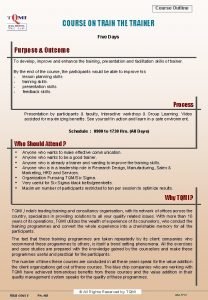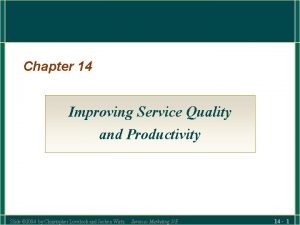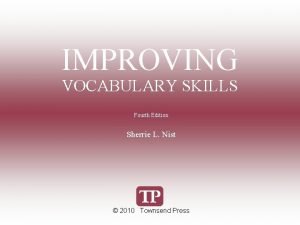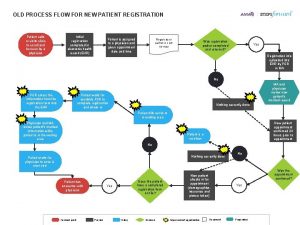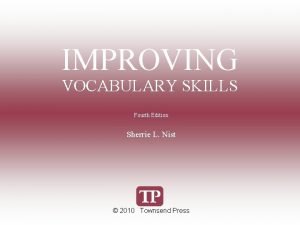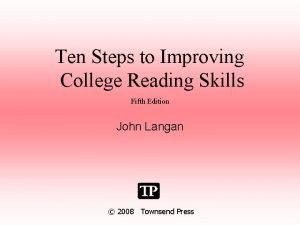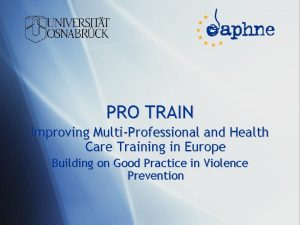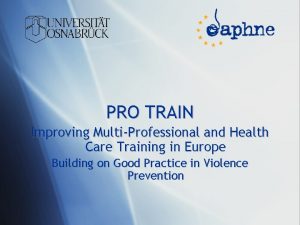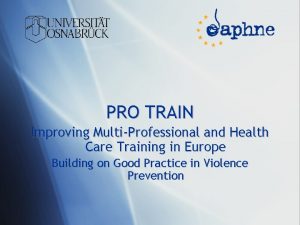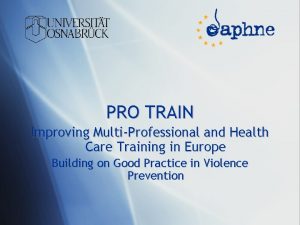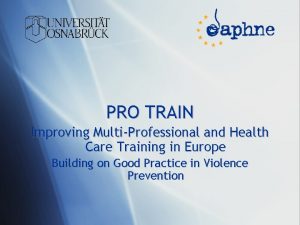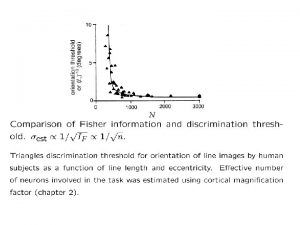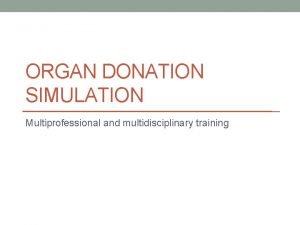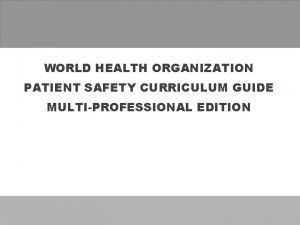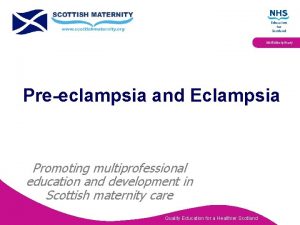PRO TRAIN Improving MultiProfessional and Health Care Training

































- Slides: 33

PRO TRAIN Improving Multi-Professional and Health Care Training in Europe Building on Good Practice in Violence Prevention

Module 1 multi-professional training: Basic information on gender based violence PRO TRAIN Improving Multi-Professional and Health Care Training in Europe

Convention on the Elimination of All Forms of Discrimination Against Women (CEDAW) In 1979, the United Nations General Assembly adopted CEDAW, which is often described as an international bill of rights for women. The Convention defines what constitutes discrimination against women and frames an agenda for action to end such discrimination. The Convention came into force 1981. As of 2 March 2006, 182 countries are party to the Convention PRO TRAIN Improving Multi-Professional and Health Care Training in Europe

CEDAW The United Nations Committee on the Elimination of Discrimination against Women (CEDAW), an expert body established in 1982, is composed of 23 experts on women's issues from around the world. The Committee's mandate is very specific: it watches over the progress for women made in those countries that are the States parties to the 1979 Convention on the Elimination of All Forms of Discrimination against Women. A country becomes a State party by ratifying or acceding to the Convention and thereby accepting a legal obligation to counteract discrimination against women. The Committee monitors the implementation of national measures to fulfil this obligation.

General Recommendation No. 19 In its General Recommendation No. 19 (1992), the UN CEDAW Committee instructs states to take all necessary and effective measures to combat all forms of gender-based violence, which “is a form of discrimination that seriously inhibits women’s ability to enjoy rights and freedoms on a basis of equality with men” (item 1). It urges governments to ensure that laws penalising violence in the family, rape, sexual assault and other forms of gender-based violence provide sufficient protection for all women and that women’s integrity and dignity be respected (item 24 b). PRO TRAIN Improving Multi-Professional and Health Care Training in Europe

General Recommendation No. 19 Victims are also entitled to services to assist in their recovery from violations of their human rights. According to General Recommendation No. 19, the state has a clear duty to provide and adequately resource protective measures, including refuges, counseling, rehabilitation and support services for women who are the victims of violence or who are at risk of violence (24 r iii). The Recommendation was the basis of the Declaration on the Elimination of Violence against Women. PRO TRAIN Improving Multi-Professional and Health Care Training in Europe

Optional Protocol CEDAW 6 th October 1999, Entry into force: 27 th December 2000 The Optional Protocol authorises the Committee on Elimination of Discrimination against Women to receive and examine communications from individuals claiming to be the victim of a breach of one of the provisions of the Convention by a party State. PRO TRAIN Improving Multi-Professional and Health Care Training in Europe

Declaration on the Elimination of Violence against Women In 1993, the UN General Assembly approved the Declaration on the Elimination of Violence against Women, the first international Human Rights document to address exclusively the issue of violence against women. It affirms that violence against women violates, impairs or nullifies women's human rights and their exercise of fundamental freedoms. PRO TRAIN Improving Multi-Professional and Health Care Training in Europe

Declaration on the Elimination of Violence against Women Proclaimed by General Assembly resolution 48/104 of 20 December 1993 Article 1: “For the purpose of this declaration the term "violence against women" means any act of gender-based violence that results in, or is likely to result in, physical, sexual or psychological harm or suffering to women, including threats of such acts, coercion or arbitrary deprivation of liberty, whether occurring in public or in private life. ” PRO TRAIN Improving Multi-Professional and Health Care Training in Europe

§ It broadens the definition of violence by including both the physical and psychological harm done towards women, and it includes acts in both private and public life. The Declaration defines violence against women as encompassing, but not limited to, § “( a ) Physical, sexual and psychological violence occurring in the family, including battering, sexual abuse of female children in the household, dowry-related violence, marital rape, female genital mutilation and other traditional practices harmful to women, non-spousal violence and violence related to exploitation; § ( b ) Physical, sexual and psychological violence occurring within the general community, including rape, sexual abuse, sexual harassment and intimidation at work, in educational institutions and elsewhere, trafficking in women and forced prostitution; § ( c ) Physical, sexual and psychological violence perpetrated or condoned by the State, wherever it occurs. ” This definition has been adopted by several international organisations. PRO TRAIN Improving Multi-Professional and Health Care Training in Europe

Declaration on the Elimination of Violence against Women are entitled to the equal enjoyment and protection of all human rights and fundamental freedoms in the political, economic, social, cultural, civil or any other field. These rights include, i. e. , the right to life, to equality, to liberty and security of person, to the highest standard attainable of physical and mental health, and the right not to be subjected to torture, or other cruel, inhuman or degrading treatment or punishment. (article 3) PRO TRAIN Improving Multi-Professional and Health Care Training in Europe

Declaration on the Elimination of Violence against Women It urges states to condemn violence against women and not to invoke any custom, tradition, or religious consideration to avoid their obligations toward its elimination. Although this declaration is a policy statement without binding force, it carries significant international legitimacy as an expression of the collective body of member nations of the UN. PRO TRAIN Improving Multi-Professional and Health Care Training in Europe

Council of Europe In 1993 the European Ministerial Conference on Equality between Women and Men adopted a delclaration stating: "Violence against women constitutes an infringement of the right to life, security, liberty and dignity of the victim and, consequently, a hindrance to the functioning of a democratic society, based on the rule of law. „ In Recommendation 1450 (2000) the Parliamentary Assembly of the Council of Europa, "condemns violence against women as being a general violation of their rights as human beings - the right to life, safety, dignity and physical and psychological wellbeing". PRO TRAIN Improving Multi-Professional and Health Care Training in Europe

Council of Europe This Rec. clearly states the widespread existence of opression of women as manifested in domestic violence, rape and sexual mutilation. It also recognizes the important role played by NGOs and "invites member states to fully support such NGO's in their national and international activities". In 2002 the Recommendation Rec(2002)5 of the Committee of Minsters to member Sates on the Protection of Women against Violence was adopted. It was the first international instrument to propose a global strategy to prevent violence and to protect the victims and it covers all forms of gender -based violence. The Recommendation also calls on governments to inform the Council of Europe on the follow-up given at national level. PRO TRAIN Improving Multi-Professional and Health Care Training in Europe

Council of Europe In 2006 the Council of Europe launched the campain ‚Stop Violence against Women, including domestic violence. www. coe. int/T/E/Human_Rights/Equality/05. _Viole nce_against_women/) PRO TRAIN Improving Multi-Professional and Health Care Training in Europe

Topic 1 Violence against woman as a human rights violations – forms and prevalence of violence PRO TRAIN Improving Multi-Professional and Health Care Training in Europe

Definition of violence WHO (2002) broad definition of violence is „the intentional use of physical force or power, threatened or actual, against oneself, another person, or against a group of community, that either results in or has a high likelihood of resulting in injury, death, psychological harm, maldevolpment or deprivation…“ (WHO 2002: World Health Report. Genava) PRO TRAIN Improving Multi-Professional and Health Care Training in Europe

Definition of domestic violence The Home Office of the UK defines domestic violence against women as “any incident of threatening behaviour, violence or abuse (psychological, physical, sexual, financial or emotional) between adults who are or have been intimate partners or family members, regardless of gender or sexuality”. (Department of Health, UK (2005): Responding to domestic abuse: a handbook for health professionals) PRO TRAIN Improving Multi-Professional and Health Care Training in Europe

Forms of domestic violence: Wheel of violence hitting, punching, kicking, gaging, absorbing, burning, rape, scalding, hurting or making her do threatening with controlling what sexual things or arms… she does, who she against sees and talks to, her will, treating what she reads, where her like a sex object, she goes, limiting her forcing her into connection to the outside watching Pornos… world… Intimidate her, vilifying her in the affronting her, social environment, threatening her, using the children as a making her think pressuring medium, she is crazy, trying to keep terrorizing her at humiliating her from getting or work… and keeping a job, debasing making her ask for her… money, giving her an allowance, taking her money… PRO TRAIN Improving Multi-Professional and Health Care Training in Europe

General Prevalence rates of violence against women in European countries § The lifetime prevalence of physical violence ranges in the European studies from 6% to over 30% § The lifetime prevalence of sexual violence by initmate partners from 4% to over 20% § The lifetime prevalence of psychological violence by intimates partners is between 12% and 42% (Martinez/Schröttle 2006) see: www. cahrv. uni-osnabrueck. de - publications PRO TRAIN Improving Multi-Professional and Health Care Training in Europe

Topic 2 Consequences of violence PRO TRAIN Improving Multi-Professional and Health Care Training in Europe

Physical Consequences § Injuries like bruise, abrasions, stab wounds, internal injuries § Fractures § Loss of teeth § Functional impairments § Permanent disabilities PRO TRAIN Improving Multi-Professional and Health Care Training in Europe

Psychosomatic Consequences § Chronic pain syndromes § Gastrointestinal disorders § Respiratory and cardiac troubles § Skin diseases § Menstruation disorders PRO TRAIN Improving Multi-Professional and Health Care Training in Europe

Psychological Consequences § Post-traumatic stress disorders § Depressions § Fears, panic attacks § Somnipathy § Eating disorders PRO TRAIN Improving Multi-Professional and Health Care Training in Europe

Unhealthy Strategy to get over an experience § Excessive nicotine consumption § Alcohol and drug abuse § Self-injuring behaviour (Source: Hellbernd, Brzank, Wieners; 2004) PRO TRAIN Improving Multi-Professional and Health Care Training in Europe

Consequences of domestic violence § § § § Actual physical injuries Reproductive consequences including infertility Gynaecological disorders Unwanted pregnancies Psychological and behavioural consequences Fatal outcomes Economic consequences Social consequences PRO TRAIN Improving Multi-Professional and Health Care Training in Europe

Topic 3 Domestic violence and effects on children PRO TRAIN Improving Multi-Professional and Health Care Training in Europe

Domestic violence and effects on children Child abuse is closely connected with partner violence. According to Heynen (2004), children are facing four typical forms of violence: 1. Fathering through rape (forced pregnancy) 2. Mistreatment during pregnancy 3. Direct experiences of violence as co-/victims of battering 4. Growning up in an atmosphere of violence and humiliation PRO TRAIN Improving Multi-Professional and Health Care Training in Europe

Domestic violence and effects on children § As direct or indirect witnesses of the violent act, children can follow the events when they are in the same room; § They register the entire aural spectrum of the violent act when they are in the adjacent room § They can feel the escalation and the destructive emotions and they wonder what it is all about (Kavemann 2000) PRO TRAIN Improving Multi-Professional and Health Care Training in Europe

Domestic violence and effects on children § Research results show that the strains, insecurities and the overtaxing that children experience as a result of violence in partnerships not only have immediate consequences but also hinder their development in the long term (Kindler 2006) § Being a witness of domestic violence is especially strainful for children, as the are deprived of the fundamental needs for safety and comfort and grow up in an atmosphere of fear and terror PRO TRAIN Improving Multi-Professional and Health Care Training in Europe

Domestic violence and effects on children § Researches found that 50% to 705 of the children being exposed to domestic violence suffer from posttraumatic stress disorders (Klotz 2000), among which are reactions such as sleeping disorders, loss of concentration, depressive moods, increased irritability and aggression (Heynen 2003). § Other symptoms may occur such as bedwetting, problems at school, delayed development, eating disorders, fearfulness, self-mutilating behaviour as well as drug and alcohol consumption. PRO TRAIN Improving Multi-Professional and Health Care Training in Europe

Domestic violence and effects on children § Older children often show a high degree of responsibility and try to protect the mother and younger siblings. § Studies verify that domestic violence has significant consequences regarding the childlike learning of problem solving methods, conflict competences and possible violent behaviour of violence experience of the children themselves in the future. PRO TRAIN Improving Multi-Professional and Health Care Training in Europe

Domestic violence and effects on children Children who co-experienced partner violence had more frequently developed gender role stereotypes, were behaving more aggressively or had greater problems in building positive relationships. PRO TRAIN Improving Multi-Professional and Health Care Training in Europe
 Health and social care component 3 health and wellbeing
Health and social care component 3 health and wellbeing Bronson intranet
Bronson intranet Improving chronic illness care model
Improving chronic illness care model Unit 2 equality diversity and rights
Unit 2 equality diversity and rights Primary, secondary, tertiary care
Primary, secondary, tertiary care Train the trainer training program outline
Train the trainer training program outline The macro pro pro maxcharltonmacrumors
The macro pro pro maxcharltonmacrumors Service quality and productivity
Service quality and productivity Difficulties of improving quality business
Difficulties of improving quality business Improving own learning and performance examples
Improving own learning and performance examples Improving vocabulary with word parts and context clues
Improving vocabulary with word parts and context clues Improving vocabulary with word parts and context clues
Improving vocabulary with word parts and context clues Improving decision making and managing knowledge
Improving decision making and managing knowledge West yorkshire health and care partnership
West yorkshire health and care partnership Humber coast and vale ics
Humber coast and vale ics Appraisal in health and social care
Appraisal in health and social care Sam and verna coursework answers
Sam and verna coursework answers Passenger management system
Passenger management system Pro health & fitness center
Pro health & fitness center Cardinal health npwt pro
Cardinal health npwt pro Ten steps to improving college reading
Ten steps to improving college reading New patient registration process
New patient registration process Improving vocabulary skills 4th edition answer key
Improving vocabulary skills 4th edition answer key Improving vocabulary skills chapter 26
Improving vocabulary skills chapter 26 Improving software economics in software project management
Improving software economics in software project management Glencoe health chapter 12
Glencoe health chapter 12 Improving software economics set 1
Improving software economics set 1 A linear-time heuristic for improving network partitions
A linear-time heuristic for improving network partitions The listening gap
The listening gap Ten steps to advancing college reading skills
Ten steps to advancing college reading skills Improving productivity at starbucks
Improving productivity at starbucks Improving vocabulary skills 5th edition
Improving vocabulary skills 5th edition A sense of belonging improving student retention
A sense of belonging improving student retention Using assessment data for improving teaching practice
Using assessment data for improving teaching practice





